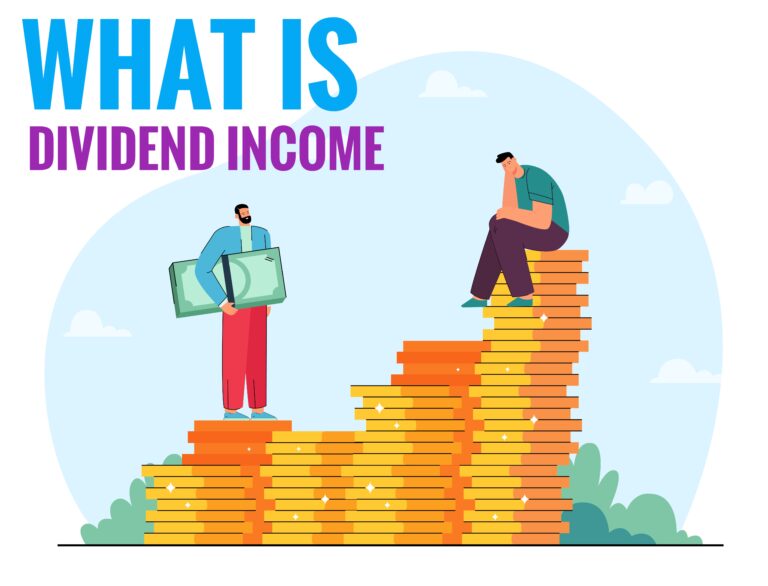
Table of Contents
Understanding dividend income and it's types
What is Dividend Income and How It Works
1. Introduction to Dividend Income
Dividend income refers to the payments that shareholders receive from companies that distribute a portion of their profits. It is a form of passive income where investors earn without needing to sell their shares. The main appeal of dividend income is that it can provide consistent earnings while allowing the investor to retain ownership in the company. There are different forms of dividend and we will learn everything one by one.
Why is Dividend Income Important?
Dividend income is especially valuable for long-term investors because it adds another layer of return in addition to potential capital appreciation. The combination of dividends and share price growth can accelerate wealth accumulation over time.
2. How Dividends Work
Definition of Dividends
A dividend amount is a part of profit sharing to its shareholders. Typically, dividends are paid in cash, though they can also be issued in the form of additional shares (stock dividends). Dividends are usually derived from a company’s profits, but they can also be paid out of reserves in certain cases.
Types of Dividends
– Cash Dividends: The most common type, these are payments made directly to shareholders.
– Stock Dividends: Instead of cash, the company rewards shareholders with additional shares of stock.
There are more types of dividends which can be a god source of income.
The company’s board of directors usually declares dividends, and shareholders receive them in accordance with their stock ownership.
3. Types of Dividend Stocks
Dividend-paying stocks can be categorized into several types:
– Blue-Chip Dividend Stocks: These are large, well-established companies with a history of steady dividend payments.
– High-Yield Dividend Stocks: Stocks that offer above-average dividend yields, often from sectors like utilities or real estate investment trusts (REITs).
– Dividend Growth Stocks: Companies that consistently increase their dividend payments over time, signaling financial health and stability.
4. How to Earn Dividend Income
Earning dividend income is straightforward: an investor must purchase shares in a company that pays dividends. Once shares are purchased, the investor is entitled to dividends when declared. Additionally, many investors choose to reinvest their dividends to buy more shares, thereby compounding their returns. There are few types of dividend incomes on the basis of which one can make a good portfolio.
5. Dividend Payment Frequency
Dividends are paid out at different intervals:
– Quarterly Dividends: Most U.S. companies pay dividends every quarter.
– Monthly Dividends: Some companies, particularly in sectors like real estate, pay dividends on a monthly basis.
– Special Dividends: Occasionally, companies will issue a one-time payment called a special dividend, which is typically higher than the regular dividend payout.
6. Taxation of Dividend Income
Dividend taxation varies based on the type of dividend:
– Qualified Dividends: These receive favorable tax treatment and are typically taxed at long-term capital gains rates.
– Non-Qualified Dividends: These are taxed as ordinary income, usually at a higher rate than qualified dividends.
Different countries have varying tax rates and rules, so investors should be aware of the tax implications in their region.
FAQs
1. Can all companies pay dividends?
No, not all companies pay dividends. Dividends are generally paid by well-established companies with stable profit and growth. Many newer or rapidly growing companies, like tech startups, often reinvest their profits into expansion rather than paying dividends.
2. How can I find companies that pay dividends?
You can find dividend-paying companies by researching stocks through financial websites or using stock screeners that filter for companies based on dividend yield, payout ratio, and dividend history. Look for sectors known for paying dividends, such as utilities, consumer staples, and real estate investment trusts (REITs).
3. What is the ex-dividend date, and why is it important?
The ex-dividend date is the cutoff date that determines who qualifies to receive the next dividend payment. If you buy a stock on or after the ex-dividend date, you won’t be eligible for the next dividend payment. To receive the dividend, you must own the stock before the ex-dividend date.
4. What is the dividend yield, and how is it calculated?
Dividend yield is a financial ratio that shows how much a company pays out in dividends relative to its stock price. It’s calculated by dividing the annual dividend per share by the stock’s current market price. Dividend yield is expressed as a percentage and helps investors assess the income-generating potential of a stock.
5. Can dividend income fluctuate?
Yes, dividend income can fluctuate based on a company’s financial performance. While some companies aim to maintain or increase their dividend payments, dividends are not guaranteed. Companies may reduce or eliminate dividends during periods of financial stress or economic downturns.
6. Is it better to reinvest dividends or take the cash?
It depends on your financial goals. Reinvesting dividends can help you grow your investment over time through compounding, which can lead to larger returns. However, if you need income to cover living expenses, you may prefer to take the cash.
